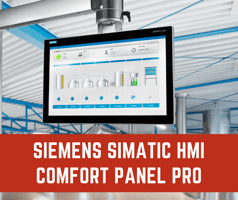Simatic HMI Panels have been at the forefront of industrial monitoring and control for years, and...
Using a Siemens HMI with a non-Siemens PLC
.png?width=300&name=ACD%20Image%20(6).png)
The Basics
A Human-Machine-Interface (HMI) is a user interface or dashboard that connects a person to a machine, device, or system. In industrial settings, HMIs can be used for a multitude of tasks including visually displaying data, tracking production time and trends, monitoring machine inputs and outputs, and much more. As industrial automation becomes increasingly digitized, HMIs have grown more and more essential to understand and interact with systems and various processes. However, there are certain roadblocks users may encounter when attempting to configure an HMI to a PLC should both products not be from the same manufacturer. Below, we’ll walk through the process of setting up and using a Siemens HMI with a non-Siemens PLC and discuss the advantages that an HMI can provide to your business.
Set-Up
Commissioning a Siemens HMI with a non-Siemens PLC is an extremely straightforward and simple process. First, using the Siemens HMI software (WinCC software), users should access the “Communications” section on the left-hand of the screen. Within the “Communications” menu, users should add a new means of communication to and from the PLC. The software will then prompt users to select a protocol with approximately twenty options to choose from. Users should select the protocol that corresponds to their PLCs specifications. For example, if you were configuring an Allen Bradley PLC, you would select one of the Allen Bradley protocols - SLC 500 for instance. Once the protocol is selected, users must set-up the IP or Modbus address of the PLC that they plan on communicating with. Next, you need to bring in the various tags from the PLC you are using. In the scenario of using an Allen Bradley PLC, Siemens has a proprietary conversion application that simplifies the process by allowing users to import your PLC tags and export the Siemens HMI tags. Finally, users just need to import that file into your program and the process is complete.
Advantages of an HMI
In addition to the benefits mentioned above, HMIs have the ability to offer even more advanced functionality for basic applications. Here are just a few of the advanced features included in a modern HMI:
- Improved Process Quality: The introduction of visualization allows for drastically improved process quality with smaller applications. With numerous software functions as standard with the device (alarm logging, trend functions, language switching, etc.), the HMI offers an entirely new set of possibilities in monitoring and operating various systems and/or machinery.
- Scalable Software: Configuration is simple and users can easily create visualization applications within a short time. Scalable software means users can start with small solutions and expand them to fit his/her needs. For example, a user could change to panels of another performance range or increase the number of tags by simply using an application.
- High-Resolution Widescreen Displays: Bigger screens with crystal-clear quality and touch screen interfaces are extremely handy and very user-friendly.
- Enhanced Usability: The HMI has improved flexibility with the USB interface - allowing the connection of a keyboard, barcode scanner, and mouse. Additionally, the USB interface allows for data archiving on a USB drive.
Interested in learning more? Connect with an ACD expert!
You may also be interested in reading:




